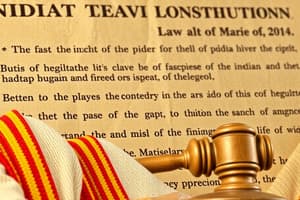Podcast
Questions and Answers
What is the Constitution?
What is the Constitution?
- A historical document from 1700s
- The supreme law of Canada
- A set of amendments
- The supreme law of the land in the United States (correct)
What is a two-thirds majority vote?
What is a two-thirds majority vote?
- A simple majority of 51%
- Votes equal to half of the total votes
- Also known as the supermajority vote (correct)
- A vote requiring 75% approval
What was the purpose of amending the Constitution?
What was the purpose of amending the Constitution?
To adjust to changing times and maintain a living document.
What is the process of amending the Constitution?
What is the process of amending the Constitution?
What is an Amendment Proposal?
What is an Amendment Proposal?
What is Amendment Ratification?
What is Amendment Ratification?
To ratify an amendment, you first need to propose it.
To ratify an amendment, you first need to propose it.
You need at least 3/4 vote of Congress to pass an amendment proposal.
You need at least 3/4 vote of Congress to pass an amendment proposal.
To ratify an amendment, you need the approval of 3/4 state legislatures and 3/4 approval at a state convention.
To ratify an amendment, you need the approval of 3/4 state legislatures and 3/4 approval at a state convention.
The Constitution can never be changed or amended even if the people think it is necessary.
The Constitution can never be changed or amended even if the people think it is necessary.
You have to be at least 18 and have lived as a legal immigrant in the U.S. for a certain period of time to become a citizen.
You have to be at least 18 and have lived as a legal immigrant in the U.S. for a certain period of time to become a citizen.
You don't have to know the basics of U.S. history and government or how to speak, read, or write to become a citizen.
You don't have to know the basics of U.S. history and government or how to speak, read, or write to become a citizen.
You have to have 'good moral character' and have not been convicted of certain crimes to become a citizen.
You have to have 'good moral character' and have not been convicted of certain crimes to become a citizen.
Flashcards are hidden until you start studying
Study Notes
Constitution
- Supreme law of the United States, established in 1787.
The Two-Thirds Majority Vote
- Known as "supermajority."
- Requires votes for a proposition to equal or exceed twice the votes against it.
Purpose of Amending the Constitution
- Amendments address societal changes and ensure the Constitution remains a "living" document as needed by the people.
Process of Amending the Constitution
- Proposals can originate from Congress (requiring a two-thirds vote from both houses) or a national convention called by two-thirds of states.
- Proposed amendments are sent to state legislatures for consideration.
Amendment Proposal
- An amendment is proposed by a vote of two-thirds in both Congressional houses or by a convention called by two-thirds of the state legislatures.
Amendment Ratification
- Requires ratification by three-fourths (38) of state legislatures or agreement from three-fourths (38) of states at conventions.
True or False: Ratification Process
- To ratify an amendment, you first need to propose it. (True)
- You need at least 3/4 vote of Congress to pass an amendment proposal. (False; only a 2/3 vote is needed)
- To ratify an amendment, you need approval from 3/4 state legislatures and 3/4 from conventions. (True)
- The constitution can never be changed or amended. (False; it can be changed through the amendment process)
Citizenship Requirements
- Must be at least 18 years old and have legal immigrant status for a necessary time period to become a citizen.
- Basic knowledge of U.S. history and government, along with proficiency in speaking, reading, or writing English, is required.
- Must demonstrate "good moral character" and not have certain criminal convictions, with an attachment to the U.S. Constitution.
Studying That Suits You
Use AI to generate personalized quizzes and flashcards to suit your learning preferences.




